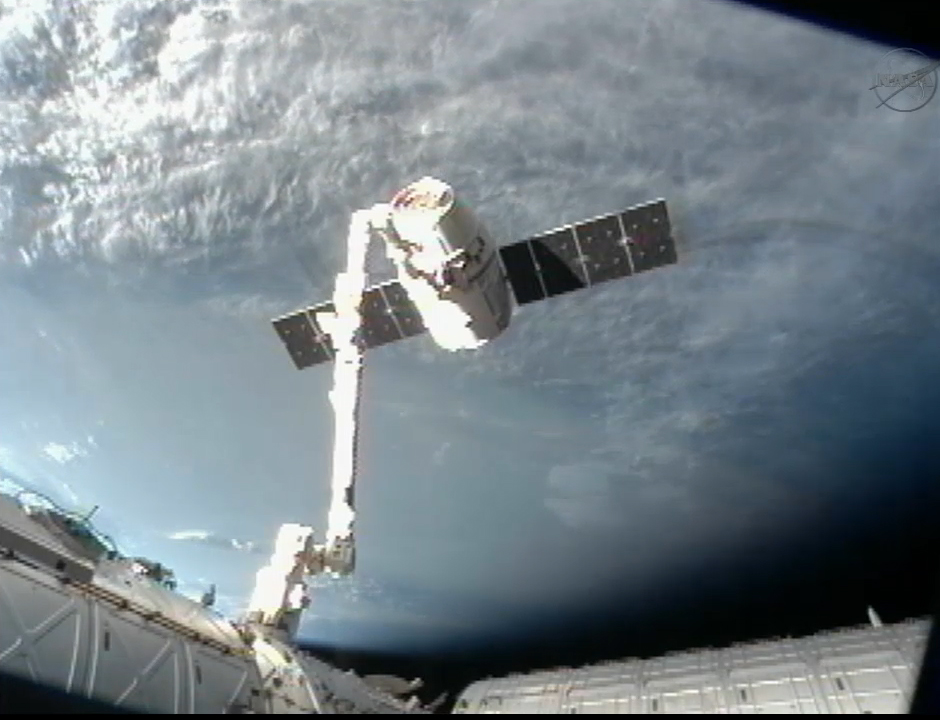Private SpaceX Capsule Lands After Historic Mission to Space Station

NASA's first commercial cargo flight ended with a splash today (Oct. 28), when the SpaceX Dragon capsule landed after a landmark mission to the International Space Station.
The unmanned Dragon space capsule, built by the U.S. company Space Exploration Technologies (SpaceX), splashed down into the Pacific Ocean off the coast of Southern California at 3:22 p.m. EDT (1922 GMT), ending a three-week visit to the orbiting laboratory.
Dragon began its descent with a de-orbit burn at 2:28 p.m. EDT (1828 GMT), after departing the station at 9:29 a.m. EDT (1329 GMT) as both spacecraft sailed 255 miles (410 kilometers) above Burma. The station's crew used the outpost's robotic arm to release the spacecraft.
"It was nice while she was on board. We tamed her [and] took her home," space station commander Sunita Williams of NASA radioed Mission Control in Houston as the Dragon capsule departed. "Literally and figuratively, there are pieces of us on that spacecraft going home to Earth."
The Dragon capsule is returning hundreds of astronaut blood and urine samples from the space station amid the 1,673 pounds (758 kilograms) of experiments and gear loaded on board. Some of those samples have been waiting for more than a year. NASA's final space shuttle mission landed in July 2011, leaving the agency without a way to return big cargo deliveries to Earth until Dragon's flight. [Photos: Dragon's 1st Space Cargo Delivery]
The spacecraft is expected to be retrieved by a SpaceX recovery crew so the cargo can be delivered to NASA. The mission is the first of 12 commercial resupply flights by SpaceX under a $1.6 billion deal with NASA.
The Hawthorne, Calif.-based SpaceX (short for Space Exploration Technologies) launched the Dragon capsule toward the space station on Oct. 7 using one of the company's own Falcon 9 rockets and a pad at Florida's Cape Canaveral Air Force Station. The capsule was packed with 882 pounds (400 kg) of supplies to for the station, including 260 pounds (117 kg) of crew gear, 390 pounds (176 kg) of scientific equipment, 225 pounds (102 kg) of hardware and several pounds of other cargo, NASA officials said.
Sign up for the Live Science daily newsletter now
Get the world’s most fascinating discoveries delivered straight to your inbox.
The cargo returning home on Dragon are 163 pounds (74 kg) of crew supplies, 866 pounds (392 kg) of scientific research and 518 pounds (235 kg) of other hardware, they added.
SpaceX is the first robotic spacecraft ever to be capable of returning cargo to Earth.
"It has been an historic mission," NASA spokesman Josh Byerly said during undocking commentary.
The unmanned cargo ships built by Russia, Japan and Europe are all designed for one-way trips and are intentionally destroyed during re-entry at the end of their missions. The Russian Soyuz capsules that ferry crews to and from the space station have limited cargo return capabilities, NASA scientists have said.
SpaceX was founded by billionaire entrepreneur Elon Musk in 2002 as a private spaceflight company. In May, the company launched its first Dragon capsule test flight to the space station to set the stage for this month's first cargo delivery flight. The next Dragon cargo mission is slated to launch in mid-January.
SpaceX is one of two companies with deals to launch cargo delivery flights on unmanned spacecraft for NASA. The other company, Virginia's Orbital Sciences Corp., has a $1.9 billion contract with the agency for at least eight missions to the station using the new Antares rocket and Cygnus spacecraft. The first Antares test flight is set for later this year.
With its space shuttle fleet retired, NASA is relying on the Dragon and Cygnus spacecraft to ferry U.S. supplies to and from the International Space Station. The space agency is also supporting the development of new commercial U.S. spacecraft to launch American astronauts on space station trips.
SpaceX is one of four companies currently developing manned private space taxis with NASA funding support. The company is upgrading its Falcon 9 rocket and Dragon capsules to eventually launch crews of seven astronauts into orbit.
This story was provied by SPACE.com, sister site to LiveScience. You can follow SPACE.com Managing Editor Tariq Malik on Twitter @tariqjmalik and SPACE.com on Twitter @Spacedotcom. We're also on Facebook & Google+.

Tariq is the editor-in-chief of Live Science's sister site Space.com. He joined the team in 2001 as a staff writer, and later editor, focusing on human spaceflight, exploration and space science. Before joining Space.com, Tariq was a staff reporter for The Los Angeles Times, covering education and city beats in La Habra, Fullerton and Huntington Beach. He is also an Eagle Scout (yes, he has the Space Exploration merit badge) and went to Space Camp four times. He has journalism degrees from the University of Southern California and New York University.











